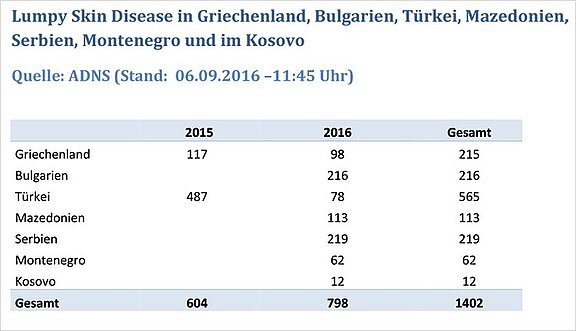Information on the current animal disease situation can be found in the respective latest issue of the monthly newsletter Radar Bulletin (in German language).
Lumpy Skin Disease (LSD) is a notifiable animal disease of cattle which is caused by capripoxviruses. LSD is endemic in Africa and the Middle East. War and expulsion promote the spread of this animal disease from areas of conflict to the neighbouring countries and finally to Europe. Since 2015, several Southeastern European countries have been affected; the disease is spreading from the Balkans in a Northwestern direction. It is mainly transmitted by arthropods.
More information on LSD can be found in the respective FLI information (download right column of this webpage).
For updated information on the LSD outbreak situation since 1 January 2015 please refer to the table and map on the German version of this webpage.
Lumpy Skin Disease (LSD) is a notifiable animal disease of cattle which is caused by Capripoxviruses. LSD is endemic in Africa and the Middle East. War and expulsion have fostered the spread of this animal disease from war zones into the bordering countries and ultimately to Europe. In Southern Europe, the case numbers of LSD have increased drastically over the last months and the disease is spreading rapidly from the Balkan States toward the Northwest. The virus is mainly transmitted by arthropods.
Epidemiological situation
LSD is endemic in most African countries and has been detected in the Middle East since 2012. In 2015, the animal disease was also reported from the Russian Federation (Caucasus region, Chechnya, and Dagestan) and was first diagnosed in Greece in August 2015. In spring 2016, first outbreaks occurred in Bulgaria and Macedonia. Since then, the disease has spread further in the Balkans. A further spread of the disease is likely.
Disease symptoms
Clinically ill animals show fever and later on typical lesions of the skin. These nodular lesions can also be rather unobtrusive and can sometimes be detected by palpation only. Often udder and teats are affected. The massive and generalized occurrence of nodular skin lesions usually affects less than 30 percent of infected cattle. In such massive clinical cases often mucosal lesions with the typical hyperemic edges and sometimes central necrosis are seen. In most cases, the local lymph nodes are swollen. In pregnant animals, abortions may occur.
It is important to know that also in viraemic animals a subclinical or asymptomatic course of disease is possible. These clinically inapparent animals complicate an early detection of the disease and can thus foster an unrecognized spread.
Suspect cases
Suspect symptoms must be clarified and adequate samples must sent to the NRL for LSD at the Friedrich-Loeffler-Institut, Greifswald-Insel Riems, without delay. Suitable sample materials are skin punches of the affected area, EDTA blood, nasal and salivary swabs.


